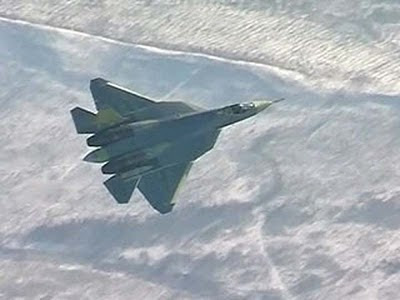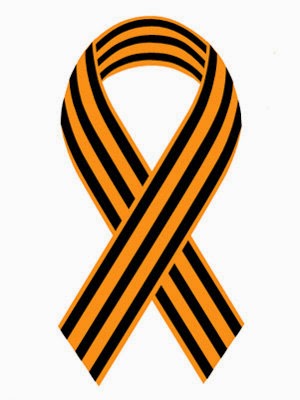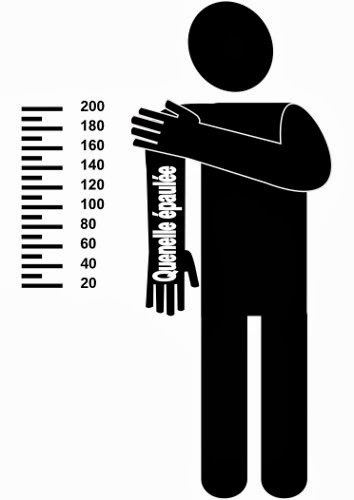The Saker
-------
Well, this brings back the old days when Flug Revue would pop out some over-the-fence shots obtained from the Military Missions in East Germany, and the assembled reptiles at Flight would adjourn to our secret analysis facility to figure out what it all meant.
First of all, for anyone contemplating the use of the word "Raptorski": don't. While this is an airplane that could have been the answer to the Advanced Tactical Fighter requirement, way back when, it's not an F-22 in many important ways.
In a lot of ways, the T-50 reflects the heritage of the T-10 Flanker series - it's much more like them than Sukhoi's last fighter prototype, the forward-swept-wing Su-47 Berkut, ever was. From the Flanker family, the T-50 gets the massive "centroplane" - a wide central body that blends the fuselage and inner wing - three-surface aerodynamic control and true three-dimensional thrust vectoring. The main weapons bay has been seen on a Flanker model, too.
 Look at some of these in detail. The centroplane is huge, extending well outside the engines and terminating at the rear in a broad beaver-tail between the exhaust nozzles.
Look at some of these in detail. The centroplane is huge, extending well outside the engines and terminating at the rear in a broad beaver-tail between the exhaust nozzles.It accommodates a boatload of fuel on the Flanker and will do the same here. After the canard hokey-pokey in the T-10 family (in on the Su-30MK, out on the Su-35) the T-50 has something different: the forward part of the leading edge extension is movable. According to the usually well informed Flateric over at Secret Projects, it is called the Povorotnaya Chast Naplyva (PChN) or movable LEX section.
3-D thrust vectoring is also used on the Su-35. The T-50 and the T-10 family are distinguished by widely separated engines, which is important because that's the only way to use vectored thrust in roll. What's new on the T-50 is that the designers have cashed in on TVC by shrinking the tail surfaces, saving on drag, weight and signature.
With separated engines and a wide body, the T-50 designers have been able to install dual front and rear weapon bays. Added to this are side bays outboard of the engines. Flateric reports that each bay is designed to hold "at least two" missiles and that the outer bays are designed for short-range AAMs. The centerline bays could each hold two large weapons (like R-33s) or three-to-four of the newly announced RVV-MD. The latter has folding wings, as does the RVV-SD development of the R-73 (AA-11 Archer) family - the latter explaining why the underwing bays are small.
The big new feature of the T-50 is stealth. The aircraft that flew today is a prototype - and it does not show visible features like a frameless canopy and panel alignment that you'd expect on a production aircraft. Other not-very-stealthy-looking features include the gaps around the inlet (compare the YF-23) and a spherical infrared search and track housing in front of the windshield. And, of course, the nozzles are round. But it has a chined forebody, edge alignment and (probably) inlet line-of-sight blockage and internal weapons.
Apparently the designers and systems analysts have looked at the thorny question of "how much stealth do we want to pay for?" and have come up with a different answer than the F-22 designers. The fact that the armed forces of potential adversaries don't have S-300 and S-400 missiles may have something to do with that answer.
Supercruise? Definitely. The aircraft has a lot of power, and you would not go with that sharply swept delta wing if that wasn't the goal.
The big question is how long the aircraft will take to enter service, which is a product of three factors - how much money is available, how many resources industry can muster to get the job done, and where the design, technically, stands at this point.
The first question depends largely on the Russian economy, and on the priority which the military gives to the fighter. At the moment, the strategic rocket forces are the priority and are elbowing all others away from the trough; also, the military could decide that the Su-35 is a good upgrade route for now. The X-factor: whether and when India will join the program, and how much cash it will involve.
The second - industry's ability to execute the program - is hard to estimate. On the downside, Russia has not inducted a brand-new aircraft into service since the 1980s. However, there are signs of a new development strategy at work here: the T-50's engines are outgrowths of the Su-35's and are being test-flown on a T-10 airframe, and the flight control system and (very likely) cockpit and avionics may be similar.
How far along is the program? Russian practice historically has been to start development with a series of prototypes that successively conform more to the production design. That's followed by an early series of aircraft that are "pre-operational" - flown by service units. Today's T-50 is, in US terms, something between a technology demonstrator and a systems development and demonstration aircraft.
Upshot - I would expect to see quite a few Su-35S regiments operational before we see a combat-ready T-50 - but with the caveat that a lot of Indian money could change things.
-------
Commentary: I would like to make a couple of small points about the video seen today. First, this is not an operational model and the final product will look substantially different. For one thing, the model shown today is covered in very non-stealthy rivets more reminiscent of the MiG-29 than the F-22. This is normal, and don't be deceived by this. The aircraft shown today was not even painted, much less so covered with radar-absorbing materials including some very high-tech paint (something of a Russian speciality). Second, if one really feels like making comparisons, the PAK-FA/T-50 has more features in common with the (abandoned) YF-23 than the F-22. (the YF-23 was, by the way, the superior aircraft of the two, but the YF-22 was chosen on political grounds). However, Bill Sweetman is absolutely correct when he writes that the real lineage of this aircraft are the Flanker series planes. In other words, the PAK-FA/T-50 is a uniquely Russian design, very different from what was developed in the USA (F-22, F-35 and even YF-23). So don't buy the "Raptorski" crap.





